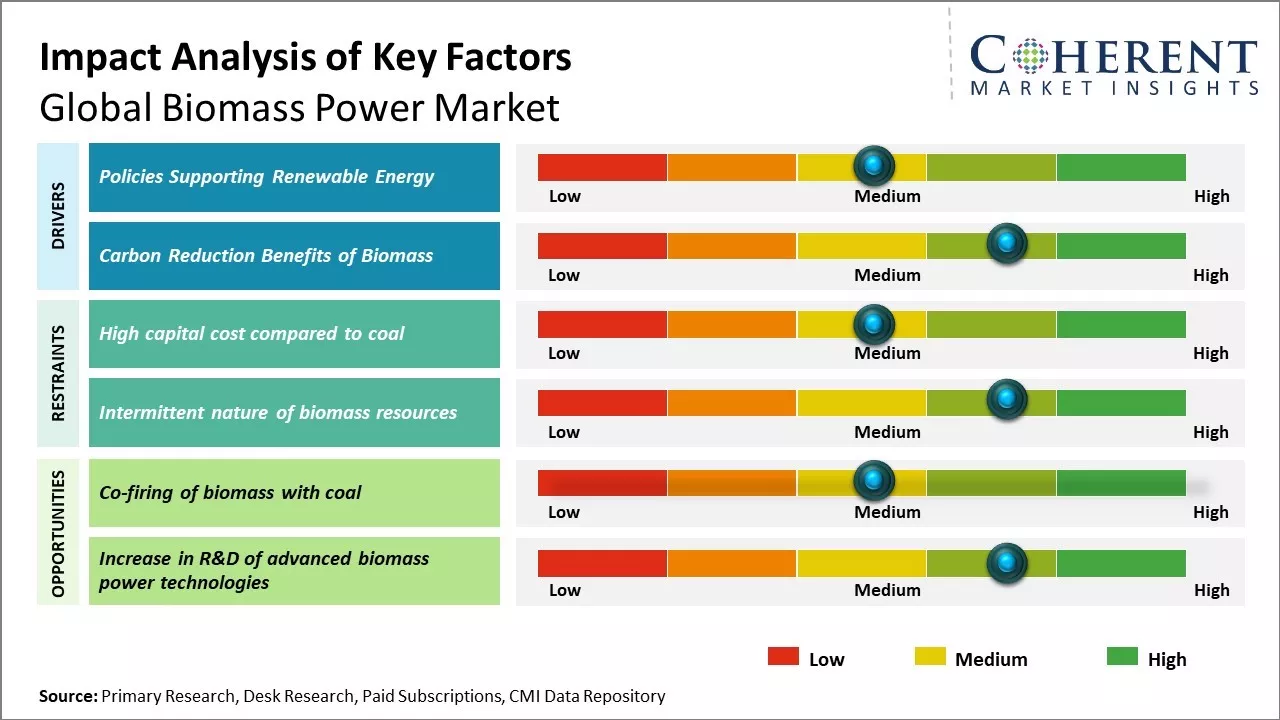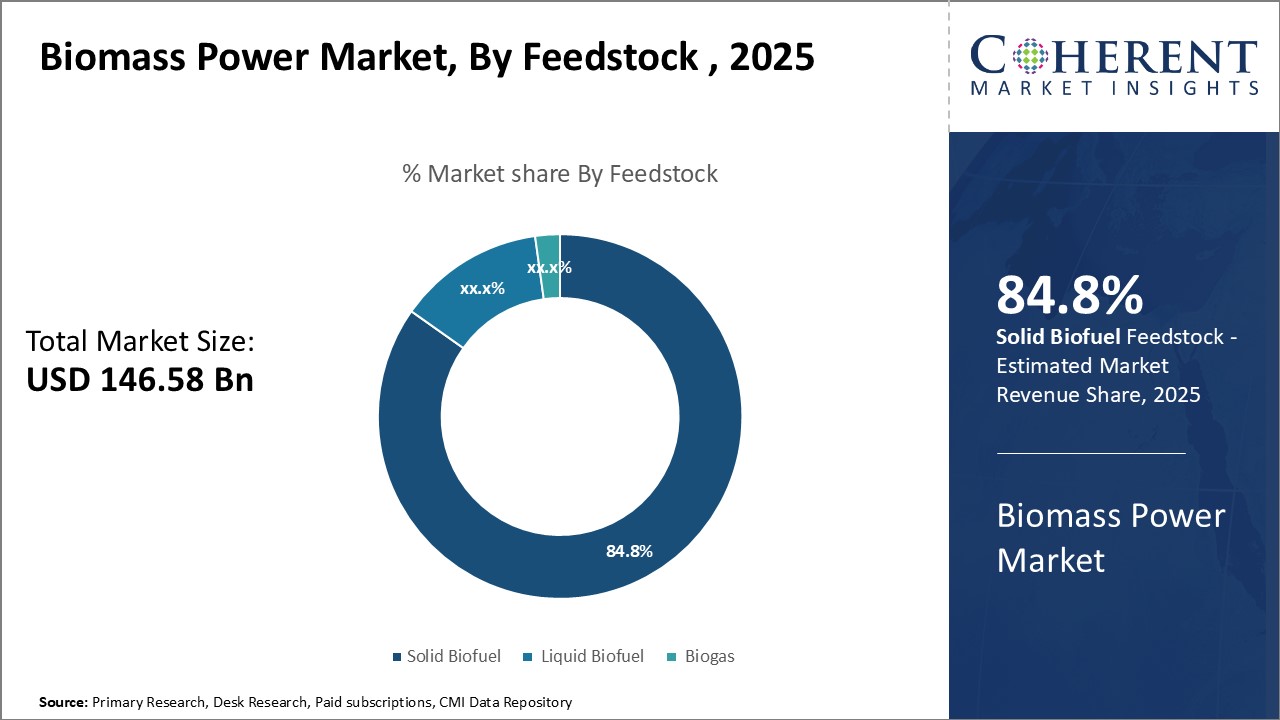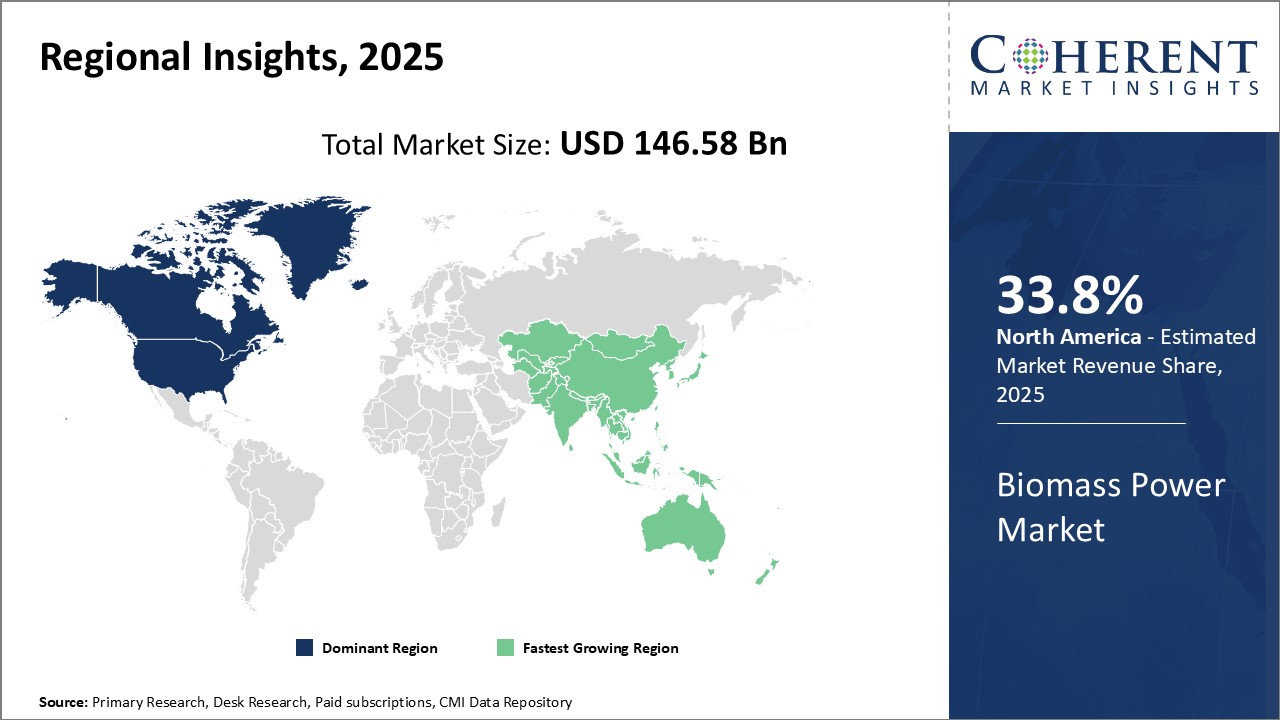Biomass Power Market Size and Trends
The Biomass Power Market is estimated to be valued at USD 146.58 Bn in 2025 and is expected to reach USD 211.96 Bn by 2032, exhibiting a compound annual growth rate (CAGR) of 5.4% from 2025 to 2032.

Discover market dynamics shaping the industry: Download Free Sample
Rising environmental concerns around the world and growing emphasis on the use of clean energy are major factors driving the demand for biomass power. Many countries are supporting the development of biomass power industry through various incentives and policies to reduce dependence on fossil fuels. Moreover, biomass is considered to be carbon neutral and help lower greenhouse gas emissions. Several power projects based on biomass gasification and combustion technologies are underway globally. Advancing technologies are also helping optimize plant capacity and efficiency. However, high production and transportation cost of biomass remains a challenge for market growth.
Policies Supporting Renewable Energy
Many countries around the world are implementing supportive policies and incentives to increase the production and usage of renewable energy in order to reduce dependence on fossil fuels and cut down carbon emissions. Biomass is one of the key renewable sources that is being encouraged through various policies. Several nations have introduced renewable portfolio standards that mandate utility companies and other large energy producers to generate a certain percentage of their power from renewable sources including biomass. Some jurisdictions provide tax credits, production based incentives, and premium pricing for biomass power producers. These measures make biomass power generation a more financially attractive business proposition. Meanwhile, biomass power plants are often exempted from various environmental compliance costs that thermal power projects have to bear. Such nudges through policy instruments have boosted investments in biomass power capacities. As more and more countries strengthen their commitments towards clean energy goals under the Paris Agreement, favorable policies for biomass are likely to spread wider.
Market Concentration and Competitive Landscape

Get actionable strategies to beat competition: Download Free Sample
Carbon Reduction Benefits of Biomass
One of the major drivers for the rising popularity of biomass power is its ability to provide carbon reduction benefits. Biomass is considered a carbon neutral source since the carbon dioxide released during combustion is equivalent to the amount absorbed by the biomass feedstock during its growth. While fossil fuel-based power generation significantly adds to greenhouse gas levels in the atmosphere, biomass power production is seen as a relatively better option to displace coal and natural gas in the energy mix of many economies. The negative emissions that biomass offers make it an appealing technology for companies and regions aiming to lower their carbon footprint. According to some research studies, replacing coal with co-firing of biomass can help reduce lifecycle emissions from power plants by over 70%. An increasing focus on environmental sustainability and various carbon pricing mechanisms are motivating greater exploitation of biomass' carbon offset advantages. This, coupled with technology improvements, is likely to result in biomass power capacity taking up a larger share of global decarbonization efforts going forward.
Key Takeaways from Analyst:
The biomass power market is expected to grow significantly over the next decade driven by the rising demand for renewable sources of energy globally. Key drivers of growth include government incentives and policies to promote renewable energy usage as well as international commitments to reduce carbon emissions.
Many countries in Europe have set ambitious renewable energy targets which will provide a strong boost to demand for biomass power in the near future.
Logistical bottlenecks in the supply chain of consistent raw biomass fuel could create downward pressure on prices in some regions. Nevertheless, the market sees strong growth opportunities in countries like the U.S., Canada, and Brazil due to the abundant availability of biomass resources like agricultural and forest residues in these nations. As environmental regulations tighten, biomass power providers could experience growing uptake in some parts of Europe and North America driven by increasing need for cost-effective alternatives to fossil fuels.
Market Challenges: High capital cost compared to coal
The high capital cost of establishing biomass power plants as compared to coal power plants is one of the major factors restraining the growth of the global biomass power market. Developing a biomass power plant requires massive initial investments for setting up the infrastructure to collect, transport and store large amounts of biomass fuel on a consistent basis. This includes investments in logistics such as warehouses, trucks and equipment related to fuel collection and preprocessing activities. Additionally, the electricity generation technologies used in biomass power plants like steam turbines also have high setup costs.
Market Opportunities: Co-firing of biomass with coal
Co-firing of biomass with coal could be a great opportunity in the global biomass power market in the coming years. Co-firing biomass reduces the carbon intensity of power generation from coal. It involves blending biomass fuels such as wood chips, agricultural residues and energy crops with coal, which can then be burned together in existing coal-fired power plants. This helps utilize existing coal infrastructure for clean energy production and provides a cost-effective way for utilities to increase use of renewable sources.

Discover high revenue pocket segments and roadmap to it: Download Free Sample
Insights by feedstock : Widespread availability and ease of production driving segment growth
In terms of Feedstock, the Solid Biofuel segment is estimated to hold 84.8% share of the market in 2025, owing to its widespread availability and ease of production. Solid biofuels mainly include biomass sources like wood waste from forestry and construction industries, agricultural residues such as straw and bagasse, and wood pellets. These solid fuels can be easily sourced from existing waste streams with minimal additional biomass cultivation required. The logistics and supply chain infrastructure for solid biofuels is also well-established due to their similarities with coal. Existing coal power plants can also be retrofitted for co-firing solid biofuels along with coal, achieving partial fuel switching with limited additional costs. Moreover, solid biofuels are stable at ambient conditions and have high energy densities which make them easier to handle and transport compared to liquid or gaseous forms of biomass. Their combustion in biomass power plants is a simple and inexpensive technology which benefits from existing expertise in conventional coal-fired systems. Overall strong availability, logistical advantage, and technological compatibility with existing coal assets contribute to the leading market share of solid biofuels.
Insights by technology: Advantages of Combustion Technology
Among technology, the Combustion segment is estimated to hold 42.8% share of the biomass power market in 2025, owing to its operational simplicity and maturity. Combustion technology involves direct firing of biomass in boilers to produce steam, which can then power steam turbines for electricity generation. It has been established at commercial scale for decades due to the relative ease of design and operation of biomass combustion systems compared to other options like gasification. Combustion also offers fuel flexibility to use a variety of solid, liquid and gaseous biomass sources. Existing fossil fuel power plant infrastructure can be retrofitted for biomass co-firing through minimal modifications, reducing investment needs. Standardized componentry and widespread EPC expertise allow swift project execution. Maintenance needs are modest as combustion plants have fewer moving parts than conversion technologies. Overall technological maturity, low investment barriers, operational stability and ease of plant augmentation have made combustion the dominant approach for harnessing biomass fuel in power generation applications.
Regional Insights

Need a Different Region or Segment? Download Free Sample
North America has established itself as the dominant region in the global biomass power market and is estimated to account for 33.8% share in 2025. With strong industry presence and supportive government policies, the U.S. accounts for the largest share of the market in the region. Biomass power production is well developed across many states, especially in the northern states with an abundance of wood resources. Several major industry players have set up production facilities catering to both domestic and international demand. The region also has a highly developed supply chain infrastructure for sourcing biomass feedstock and transportation to conversion facilities. Stringent emission norms have further boosted demand for biomass power as a replacement for retiring coal-based capacities.
On the other hand, Asia Pacific has emerged as the fastest growing regional market for biomass power. Countries like China and India offer immense untapped potential due to their large populations and growing energy needs. Both nations are heavily focusing on developing renewable sources to meet electricity demand from industrialization and urbanization. Biomass is seen as a key part of their energy transition strategy, helping to diversify away from fossil fuels. In China, biomass power capacity addition is supported through various subsidy schemes, preferential tariffs and tax incentives provided to clean energy projects. Meanwhile, India has launched an ambitious program to add new biomass power capacities by promoting private sector participation through suitable policy framework.
Market Report Scope
Biomass Power Market Report Coverage
| Report Coverage | Details | ||
|---|---|---|---|
| Base Year: | 2024 | Market Size in 2025: | USD 146.58 Bn |
| Historical Data for: | 2020 To 2024 | Forecast Period: | 2025 To 2032 |
| Forecast Period 2025 to 2032 CAGR: | 5.4% | 2032 Value Projection: | USD 211.96 Bn |
| Geographies covered: |
|
||
| Segments covered: |
|
||
| Companies covered: |
Mitsubishi Heavy Industries, Ltd., Suez, Xcel Energy Inc., Ramboll Group A/S, Babcock & Wilcox Enterprises, Inc., Orsted A/S, Ameresco, General Electric, Veolia, Vattenfall, Dalkia EnviTec Biogas AG, Weltec Biopower GMBH, Drax Group PLC (UK), Enviva LP, Sodra, MVV Energie AG, Helius Energy PLC, Alstom SA, and Vattenfall AB |
||
| Growth Drivers: |
|
||
| Restraints & Challenges: |
|
||
Uncover macros and micros vetted on 75+ parameters: Get instant access to report
Biomass Power Industry News
- In June 2024, Malakoff launched biomass co-firing project and targets 15% capacity by 2027
- In February 2024, Epson Plans Construction of Biomass Power Plant
- In 2023, Sojitz Begins Commercial Operations of One of Japanese Largest Biomass Power Plants in Tomakomai, Hokkaido
- In 2020, Cuba launched the first biomass power plant
*Definition: The biomass power market involves production and sale of electricity by burning biomass fuel sources such as wood, waste from agriculture or forestry, and municipal solid waste from biodegradable products and food waste. Biomass power plants use these organic materials to generate steam that drives turbines to produce electrical power. The biomass power market has witnessed significant growth over the past few years due to its potential as a renewable source of energy generation and is expected to continue expanding driven by rise in global investments in alternative energy.
Market Segmentation
- Feedstock Insights (Revenue, USD Bn, 2020 - 2032)
- Solid Biofuel
- Liquid Biofuel
- Biogas
- Technology Insights (Revenue, USD Bn, 2020 - 2032)
- Combustion
- Gasification
- Anaerobic Digestion
- Regional Insights (Revenue, USD Bn, 2020 - 2032)
- North America
- U.S.
- Canada
- Latin America
- Brazil
- Argentina
- Mexico
- Rest of Latin America
- Europe
- Germany
- U.K.
- Spain
- France
- Italy
- Russia
- Rest of Europe
- Asia Pacific
- China
- India
- Japan
- Australia
- South Korea
- ASEAN
- Rest of Asia Pacific
- Middle East & Africa
- GCC Countries
- Israel
- Rest of Middle East & Africa
- North America
- Key Players Insights
- Mitsubishi Heavy Industries, Ltd.
- Suez
- Xcel Energy Inc.
- Ramboll Group A/S
- Babcock & Wilcox Enterprises, Inc.
- Orsted A/S
- Ameresco
- General Electric
- Veolia
- Vattenfall
- Dalkia EnviTec Biogas AG
- Weltec Biopower GMBH
- Drax Group PLC (UK)
- Enviva LP
- Sodra
- MVV Energie AG
- Helius Energy PLC
- Alstom SA
- Vattenfall AB
Share
Share
About Author
Yash Doshi is a Senior Management Consultant. He has 12+ years of experience in conducting research and handling consulting projects across verticals in APAC, EMEA, and the Americas.
He brings strong acumen in helping chemical companies navigate complex challenges and identify growth opportunities. He has deep expertise across the chemicals value chain, including commodity, specialty and fine chemicals, plastics and polymers, and petrochemicals. Yash is a sought-after speaker at industry conferences and contributes to various publications on topics related commodity, specialty and fine chemicals, plastics and polymers, and petrochemicals.
Missing comfort of reading report in your local language? Find your preferred language :
Transform your Strategy with Exclusive Trending Reports :
Frequently Asked Questions
EXISTING CLIENTELE
Joining thousands of companies around the world committed to making the Excellent Business Solutions.
View All Our Clients
